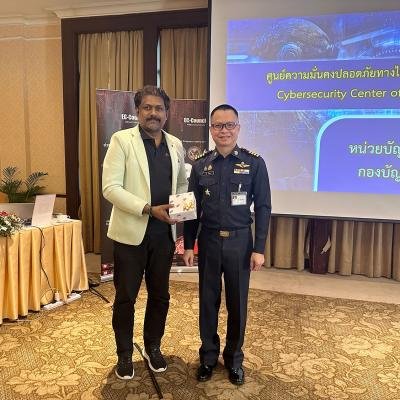In today's interconnected world, where mobile devices have become an integral part of our daily lives, ensuring the security of our endpoints and mobile devices is of paramount importance. Endpoint security and mobile device protection are crucial components of any comprehensive cybersecurity strategy. This blog post aims to delve deeper into the significance of endpoint security and provide valuable insights into effective mobile device protection strategies.
Understanding Endpoint Security:
Definition and Scope:
Endpoint security refers to the practices and technologies employed to secure network endpoints, including laptops, desktops, servers, and mobile devices. It encompasses a range of measures, such as antivirus software, firewalls, encryption, and access controls, to protect endpoints from unauthorized access and malicious activities.
Importance of Endpoint Security:
Endpoints serve as entry points for cyber attackers seeking to infiltrate networks and compromise sensitive data. An endpoint breach can lead to data theft, financial losses, reputational damage, and even regulatory non-compliance. By focusing on endpoint security, organizations can effectively mitigate these risks and protect their critical assets.
Endpoint Security Challenges:
Securing endpoints poses unique challenges for organizations. With the proliferation of diverse device types, including smartphones, tablets, and IoT devices, there is a need to secure each endpoint without impeding productivity. Additionally, the rise of remote workforces and the increasing sophistication of attack vectors add complexity to endpoint security efforts.
Common Threats to Endpoint Security:
Malware and Ransomware:
Malware, including viruses, worms, and Trojans, poses a significant threat to endpoints. Ransomware, a particularly destructive form of malware, encrypts files and demands a ransom for their release. Organizations must employ robust antivirus and anti-malware solutions, along with regular scanning and threat intelligence, to detect and mitigate these threats.
Phishing and Social Engineering:
Phishing attacks target endpoint users through deceptive emails, messages, or websites, tricking them into divulging sensitive information such as passwords or financial details. Social engineering tactics exploit human vulnerabilities to gain unauthorized access. User education, spam filters, and web filtering are essential defenses against these threats.
Insider Threats:
Insider threats, arising from negligent or malicious actions of employees, contractors, or partners, can bypass traditional security measures. Organizations must implement stringent access controls, monitor user activities, and foster a culture of security awareness to mitigate the risks associated with insider threats.
Best Practices for Endpoint Security:
Regular Software Patching and Updates:
Outdated software and operating systems often contain vulnerabilities that can be exploited by cybercriminals. Regular patching and updates are vital to address these vulnerabilities and protect endpoints from known threats. Organizations should establish patch management processes and leverage automated tools to streamline this practice.
Strong Authentication and Access Control:
Implementing strong authentication mechanisms, such as multi-factor authentication (MFA), helps verify the identity of users and protect against unauthorized access. Additionally, enforcing access control policies based on the principle of least privilege ensures that users only have the necessary permissions to perform their tasks, reducing the risk of potential breaches.
Endpoint Detection and Response (EDR):
EDR solutions provide real-time monitoring and response capabilities to detect and respond to advanced threats. These solutions leverage behavioral analysis, machine learning, and threat intelligence to identify and mitigate malicious activities on endpoints. EDR plays a crucial role in minimizing the dwell time of threats and enhancing incident response capabilities.
Employee Training and Awareness:
Investing in regular cybersecurity training and awareness programs for employees is essential. Educating users about common threats, safe browsing habits, and best practices for handling sensitive information can significantly reduce the likelihood of successful attacks. Ongoing training ensures that employees stay informed about the evolving threat landscape and are equipped to make sound security decisions.
Mobile Device Protection:
Mobile Threat Landscape:
Mobile devices face unique risks, including app-based vulnerabilities, mobile malware, and data leakage. With the growing reliance on mobile devices for work-related tasks, securing these endpoints becomes paramount. Organizations must adopt a holistic approach to mobile device protection.
Mobile Device Management (MDM):
MDM solutions enable organizations to manage and secure mobile devices by enforcing policies, controlling access, and remotely monitoring devices. MDM provides features such as remote wipe, device encryption, and application whitelisting, allowing organizations to maintain control over corporate data while respecting employee privacy.
Bring Your Own Device (BYOD) Policy:
Implementing a BYOD policy presents organizations with both challenges and opportunities. While allowing employees to use their personal devices for work improves productivity and flexibility, it introduces security risks. Organizations must establish clear policies outlining security requirements, such as device encryption, secure network connections, and containerization, while respecting employee privacy concerns.
Mobile Application Security:
Vetting and securing mobile applications are crucial to prevent malicious code injection and unauthorized access to sensitive data. Organizations should establish a process for evaluating the security of mobile apps before deploying them to endpoints. This includes verifying the reputation of developers, conducting code analysis, and implementing app sandboxing to isolate apps from sensitive data.
Emerging Technologies for Endpoint Security and Mobile Device Protection:
- Zero Trust Architecture:
Zero Trust is a security framework that assumes no implicit trust within the network, even for internal users or devices. It requires continuous verification of identities, strong authentication, and granular access controls. Implementing Zero Trust principles enhances endpoint security by reducing the attack surface and minimizing the impact of potential breaches.
- Artificial Intelligence (AI) and Machine Learning (ML):
AI and ML technologies have transformed the field of cybersecurity. They can enhance endpoint security by detecting anomalies, identifying patterns indicative of attacks, and automating threat response. ML-powered endpoint protection platforms can analyze vast amounts of data to identify and mitigate potential threats in real-time.
- Blockchain Technology:
Blockchain has the potential to revolutionize mobile device protection by enhancing data integrity, privacy, and security. It can enable secure device authentication, secure transactions, and decentralized identity management, reducing reliance on centralized authorities. While still in its early stages, blockchain shows promise for improving the security of mobile endpoints.
Examples and Evidence:
- Example: The Equifax Data Breach
- Evidence: In 2017, Equifax, one of the largest credit reporting agencies, suffered a massive data breach that exposed the personal information of 147 million people. The breach was caused by a vulnerability in an unpatched Apache Struts web application framework on an endpoint. This incident highlights the importance of regular software patching and updates to prevent endpoint vulnerabilities.
- Example: WannaCry Ransomware Attack
- Evidence: The WannaCry ransomware attack in 2017 infected hundreds of thousands of endpoints worldwide, including those in major organizations such as the UK's National Health Service (NHS). The attack exploited a vulnerability in outdated Windows operating systems. This incident demonstrates the devastating impact of ransomware on endpoint security and the need for robust protection measures.
- Example: Verizon Data Breach Investigations Report
- Evidence: The annual Verizon Data Breach Investigations Report provides valuable insights into endpoint security threats. The 2021 report revealed that 85% of breaches involved a form of malware, highlighting the persistent threat posed by malware to endpoint security. The report also indicated that 36% of data breaches involved phishing attacks, emphasizing the importance of user awareness and training.
- Example: Ponemon Institute's State of Endpoint Security Risk Report
- Evidence: The 2021 State of Endpoint Security Risk Report by Ponemon Institute revealed that 68% of organizations experienced an endpoint attack that compromised data or IT infrastructure in the past 12 months. The report identified the challenges faced by organizations in securing endpoints, such as diverse device types, remote workforces, and balancing security with user productivity.
- Example: Mobile Security Report by Verizon
- Evidence: The 2021 Mobile Security Report by Verizon highlighted the growing threats to mobile devices. The report found that 46% of respondents experienced a mobile-related security compromise in the past year. It emphasized the risks associated with mobile malware, malicious apps, and vulnerabilities in mobile operating systems, underscoring the need for robust mobile device protection strategies.
- Example: Case Study on Mobile Device Management (MDM)
- Evidence: A case study conducted by VMware showcased the benefits of implementing an MDM solution. The study demonstrated that organizations achieved centralized management, enforced security policies, and ensured data encryption on mobile devices by using an MDM solution. This case study provides evidence of the effectiveness of MDM in protecting mobile devices and data.
- Example: Case Study on Zero Trust Architecture
- Evidence: A case study conducted by Forrester Consulting revealed the positive impact of implementing a Zero Trust architecture. The study showed a 35% reduction in security incidents and a 51% reduction in the impact of security incidents. This case study provides evidence of the effectiveness of Zero Trust principles in enhancing endpoint security.
Conclusion:
Endpoint security and mobile device protection are paramount in safeguarding the digital frontier. As our interconnected world continues to evolve, the need to secure endpoints and mobile devices becomes increasingly critical. By implementing robust security measures, staying vigilant about emerging threats, and adopting cutting-edge technologies, organizations and individuals can fortify their digital presence against malicious actors, preserving data integrity and mitigating risks.
The ever-evolving threat landscape necessitates a comprehensive approach to endpoint security and mobile device protection. Organizations must recognize the diverse range of endpoints, from laptops and desktops to smartphones and IoT devices, and implement a multi-layered defense strategy. This includes utilizing firewalls, antivirus software, intrusion detection systems, encryption, and access controls to mitigate potential vulnerabilities.
Remaining informed about emerging threats is crucial for effective endpoint security. Industry reports, such as the Verizon Data Breach Investigations Report and the Ponemon Institute's State of Endpoint Security Risk Report, provide valuable insights into common attack vectors and trends. By leveraging this knowledge, organizations can proactively implement security measures to counteract prevalent threats like malware, ransomware, phishing attacks, and insider threats.
Real-world incidents serve as stark reminders of the consequences of inadequate endpoint security. The Equifax data breach and the WannaCry ransomware attack showcased the severe impact of unpatched vulnerabilities and unmitigated ransomware infections. These incidents highlight the urgent need for regular software patching, updates, and strong security protocols to protect endpoints from increasingly sophisticated threats.
Mobile device protection is equally crucial in the digital frontier. With the widespread use of smartphones and tablets in personal and professional settings, implementing robust mobile device management (MDM) solutions becomes imperative. This includes enforcing security policies, ensuring data encryption, and addressing the challenges posed by Bring Your Own Device (BYOD) policies.
Cutting-edge technologies offer promising avenues for enhancing endpoint security and mobile device protection. Zero Trust Architecture, supported by case studies, minimizes the attack surface by continuously verifying identities and implementing strict access controls. Artificial Intelligence (AI) and Machine Learning (ML) empower security solutions to detect and respond to advanced threats in real-time, augmenting endpoint security measures. Blockchain technology holds potential for secure mobile device authentication and decentralized identity management, ensuring data integrity and privacy.
In conclusion, endpoint security and mobile device protection are indispensable in safeguarding the digital frontier. By adopting comprehensive security measures, staying informed about emerging threats, and leveraging cutting-edge technologies, organizations and individuals can fortify their endpoints and mobile devices against the evolving threat landscape. Real-world incidents and evidence from industry reports emphasize the importance of proactive protection in maintaining a secure cyber environment. As a trusted provider of digital security solutions, digiALERT is dedicated to helping organizations and individuals safeguard their digital assets and preserve the integrity of their digital presence in this ever-changing digital landscape.







